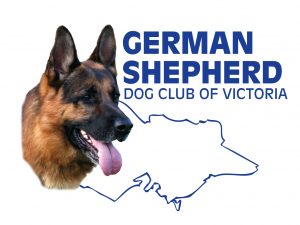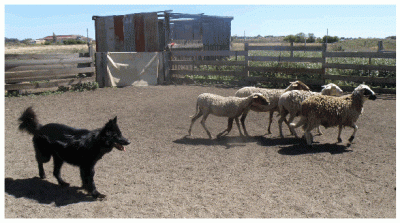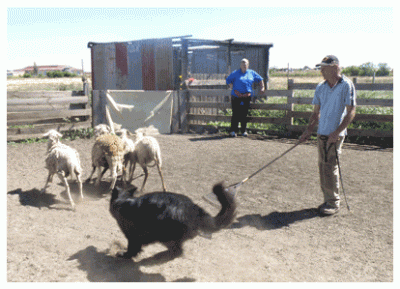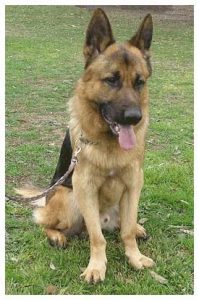Members’ stories
This section is for members who are so proud of their GSDs that telling family, friends and other dog enthusiasts about their dogs and their achievements is simply not enough. We want everyone to know!
So this is the place where you can boast about your GSD. The stories may involve participation in various trials, competitions or general activities, amusing anecdotes or tales how your dog became a member of your family. Sharing your story may entertain or help to educate other owners of GSDs and there are many of us out there.
If you have a story you would like told, please contact us at geelong@gsdcv.org.au
Canine companions
Asa and Mac at Drysdale Grove Aged Care Facility
Geelong Branch was asked by Drysdale Grove Aged Care Facility whether it would be possible to have some of our dogs visit their facility in Drysdale.
Ashley Kendall with Asa and myself with Mac took up the offer.
We arrived at the aged care facility at 1 pm on Friday for a visit to the residents’ day room. I was a bit concerned that Mac and Asa would be overwhelmed by all the wheelchairs and walking frames (both dogs had a secret passion for turning wheels) but there was no need for concern as both were relaxed and not bothered by any of the comings and goings.
There were about 30 residents forming a circle with their wheelchairs and frames, allowing Mac and Asa to meet and greet them all. Both dogs speak on command, thrilling the residents with their special ‘hello’.
We did a small demonstration with some heeling, sit stays and drop stays while Ash explained the commands as we went along.
Then there were some more and greets and some happy snaps with some of the residents. At the end of the visit, there was a big round of applause from the appreciative residents.
We were then asked to visit the rooms of those who were unable to attend the dayroom activities. There was more meeting and greeting and, in one room, Mac looked longingly at some brightly coloured bed socks twitching at the end of the bed – he just loves teddies!
Both Mac and Asa were extremely well-behaved and very gentle with the aged residents. They represented their breed and the Geelong Branch very positively and have been invited to come back for more visits.
P.S. Ash and I also behaved!
Maureen Williams, 2010
Herding antics
Doing what comes naturally
At 16 months, Sadie was a 16-month-old black bundle of energy with attitude to spare – the sort of dog that makes a first-time dog owner throw up her hands in despair at her sheer inadequacy as a trainer. Searching for activities that would appeal to this dog with a high drive, I discovered David Higgins’ Diggers Herding where dogs such as the GSD were able to practise their natural instinct to herd.
Arriving on a very pleasant Sunday morning, Sadie and I joined several dogs, including kelpies, koolies and border collies, at David’s Digger’s Rest property to participate in a herding workshop for beginners. Here we received information on herding and herding dogs as well as opportunities for our dogs to show us what they could do.
Sadie’s first encounter with a small flock of sheep was a little underwhelming. Never having seen a sheep, let alone been in contact with one, Sadie first sniffed their backsides. Then there was a little bit of sheep chasing happening under the eagle eye of David who, with rake in hand, was encouraging her instincts to kick in. However, uncertain about the rake and excited by the environment, Sadie was easily distracted by sheep in the next yard, other dogs watching through the fence and the apparently delicious, fresh sheep dung on the ground.
However, following lunch and a rest in the car, Sadie was a different dog the second time round. As soon as she entered the yard, she was totally focussed on the sheep: she was actively engaged in herding them and bringing stray sheep back into the fold as though she had been doing it for years. More difficult was her ability and willingness to listen to and obey the trainer’s command to stop in her tracks (no surprise there!). I had to turn away from her as she came to me in an effort to escape David’s demands but she eventually did so and was immediately rewarded by being released to resume her herding.
Her third attempt was not as successful. She was tired and a little distracted and when I stepped in to take hold of the rake to direct her, she became a little more aggressive in her herding. Clearly not as respectful as she should be! David had to step in and we ended the final session on a less glorious note.
A month later, we returned for a second session. This time she knew what to expect and immediately went into herding mode. Unlike the former mob of sheep, this mob was a little less forgiving of amateur antics and Sadie was more excited. She was totally impervious to any direction and even a thrown rake failed to distract her from chasing the sheep. At one point she became so intent that when she reached a sheep, she managed to remove a clump of wool (no flesh fortunately!)
While nipping is occasionally called for, Sadie had stayed in predator mode instead of herding mode and such nipping was inappropriate. The sheep themselves became a little stressed and one was so spooked and leapt up, bouncing off my shoulder in its attempt to escape Sadie.
This over-enthusiasm remained with each of the three tries and, when it came to a final herding in a larger pen, David wisely suggested that we pass for, as he commented, any illusion of control in the small pen would be totally lost in a larger pen.
We are still to have another attempt and perhaps this time, with a little more age on her side, she might be a little more amenable to commands and the sheep will be a little safer.
Veronica Filmer, 2011
Inspiring moments
Kupa
Being a large, fast-growing breed, the German Shepherd Dog faces the risk of developing hip or elbow dysplasia as they get older. In essence, this means that the hip and elbow joints do not fuse properly and there may be frequent dislocation, lameness or severe arthritis.
For this reason, until at least the age of 12 months and only in moderation until 18 months, large breed puppies should be discouraged from going up and down stairs, jumping onto sofas or beds, leaping in and out of the car or going for walks much longer than 10-15 minutes with breaks.
Not all owners, however, are aware of this inherent predisposition. For the luckier dog, their living conditions pose no risk and they grow up without any problems. For those less fortunate, the lack of knowledge can be potentially disastrous.
This was the case for Kupa, a GSD puppy who found a home with an owner who doted on this small bundle of energy. Like most puppies, Kupa loved to run about, following his owner around the house, racing up and down the stairs of their two-storey dwelling and generally getting into innocent mischief. Little did he and his owner realise that those stairs were causing an enormous amount of stress on the immature joints.
Then, in an act of concern, the owner unwittingly increased the risk of damage to Kupa’s joints. Worried about his lean appearance, Kupa was taken to a vet who prescribed a high protein puppy food to help him put on weight. The sudden and persistent increase in weight, combined with Kupa’s natural growth spurts and his movement up and down stairs, proved too much.
By the time he was five months old, Kupa began to display a degree of discomfort and pain in his front legs that soon led to severe lameness. Unhappy, the owner contacted Kupa’s breeder, informed her of his condition and stated that, being unprepared to commit to surgical intervention and rehabilitation, Kupa would be put to sleep.
This telephone call saved Kupa’s life.
Although days away from travelling to the USA, the breeder immediately collected Kupa and took him to her vet. Kupa was diagnosed with ‘ununited anconeal process’ (UAP) – the anconeal process, a bony projection on the ulna at the back of the elbow, had not fused with the rest of the ulna and had instead formed a separate bone that prevented the leg from extendi ng and caused considerable pain.
Kupa suffered from UAP in both front legs and, in order to free up the movement in his elbows, the vet advised the removal of both bony projections.
For the breeder, this was devastating news. His parents had tested with excellent elbow and hip scores, so to find one of their puppies in such a state was extremely distressing. Like all ethical and responsible breeders, the breeder had an emotional investment in the wellbeing of her puppies, even after they had gone to new homes. To see Kupa in pain was unbearable and, knowing that with surgery the young puppy could still lead a fulfilling life, she authorised the necessary operation.
With her overseas departure imminent, however, the breeder needed to find a temporary home where Kupa could recuperate. She called her friend, Barbara Pownall, who had extensive experience with GSDs. Barb agreed to care for Kupa for the three weeks that the breeder would be out of the country.
Kupa entered the Powell family at a time when Barb’s son, Clint, was on the long road to recovery from a serious motocross accident that had left him in a coma. After months of rehabilitation, Clint was able to start jogging. Setting the 2010 GSDCV endurance trial in their sights, Clint and GSD family member, Chase, began training for the 20 km stag ed course. In a field of 12, Clint was one of only 2 joggers starting and keeping up with the bike riders. It was with great pride on the part of his family and great joy for all those who knew him, Clint and Chase had passed the course with flying colours.
Despite this success, Clint was still in the process of healing when Kupa arrived. There was an immediate kinship between the two wounded beings that was made poignantly evident when, in an unconscious movement, Clint reached out and patted Kupa with a hand that had been stiff and immobile. The young, easy-going puppy was actively helping Clint in his rehabilitation just as Chase had done and, in turn, the Pownall family was allowing him to thrive.
Nearly two years later and Kupa has become a valued member of Barb’s family. He recovered well from his operation and has transformed from an overly lean, very bow-legged timid dog, to a healthy, confident young male and, although still slightly bow-legged, is able to race around his backyard and with his playmates at the Geelong Branch grounds.
A sweet-tempered dog, Kupa’s life has been transformed. While he will never be able to show, and agility activities are certainly out of the question, Kupa can still participate in obedience or tracking or simply enjoying life with his family and friends.
It is thanks to the owner, who gave Kupa a chance by making the phone call, the breeder, who did not turn away from the problem and was able and prepared to give him the treatment he needed, and Barb, who generously took him in, th at Kupa continues to touch people’s lives.
Tracking tales
In 2005, Jo Mee with River and Dennis Gladman with Shadow, took part in a tracking trial at Haddon. Dennis subsequently wrote about his experiences and, although an old story, it is worth recounting it here for anyone interested in tracking.
A day at a Tracking Trial
I don’t know about Jo, but I didn’t get much sleep during the night. Too excited and too worried about sleeping through the alarm.
Up at 4 am to get dressed, make coffee and put Shadow in the car.
Meet Jo at the Corio Library at 5 am.
We travelled up the highway in convoy towards Ballarat.
Arrived at Haddon at 6.50 am; this is about 10 km out the other side of Ballarat.
The sun is just starting to rise.
We checked in with our judge at 7.15 am and proceeded to draw numbers out of a hat to see what time our respective tracks would start.
Jo and River
For those who don’t know, Jo and River were entered in TQT. TQT stands for tracking qualification test. The track is 300 metres in length and has one 90 degree turn, either left or right. The track layer for TQT and Test One can be known to the dog.
The judge took me to a farm paddock which had three flags in it. He tells me which flag to start at and to leave one of my old socks at the base of that flag. I then proceed to walk to the next flag. Once there, I remove that flag and turn 90 degrees and walk to the last flag. Again I remove this flag and then lay flat on the ground, remaining very still and quiet.
After about ten minutes, the judge brings Jo and River to the gate in the paddock. He tells Jo that the track starts at the only flag standing in the paddock and wishes her good luck. Jo doesn’t know which direction the track layer went, so she has to completely trust in her dog’s ability.
Jo and River walk up to the flag that has one of my smelly old socks laying there and lets him sniff it. She then tells River to track and find him. River started off well, bum up and nose down. He followed my track perfectly but was going so fast he overshot the turn.
The rabbit holes near the fence distracted him too much, so the judge called him back to where the turn was. Again River followed my track straight to where I was lying in the long grass.
He found the track layer but, because he missed the corner, he failed his TQT. Don’t worry Jo, there’s always another day and you must admit, it was a lot of fun!
Dennis and Shadow
And now a brief run down of my Test One track.
Jo was my designated track layer. My track was 800 metres in length and consisted of four 90 degree turns and one 45 degree turn. Along the track, Jo has to drop two of her socks and Shadow has to find at least one of them and the track layer to pass.
Half an hour after the track was laid, we started. After starting off in the wrong direction twice and being called back by the judge, we failed. However, we did manage to find one of her socks, and Jo at the end of the track.
Distractions such as sheep and cow manure and three partly decomposed sheep carcasses didn’t help very much. That’s tracking: you never know what you will get. It might be a track through the bush or a track through farmland. One person on the day had a mob of kangaroos cross right in front of them. This distracted the dog momentarily, but he had already failed his test.
Out of our group of nine dogs, only three gained a pass on the day.
Dennis Gladman, 2005





